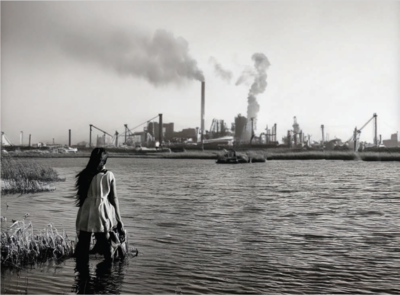Welcome at the Interface Culture program website.
Acting as creative artists and researchers, students learn how to advance the state of the art of current interface technologies and applications. Through interdisciplinary research and team work, they also develop new aspects of interface design including its cultural and social applications. The themes elaborated under the Master's programme in relation to interactive technologies include Interactive Environments, Interactive Art, Ubiquitous Computing, game design, VR and MR environments, Sound Art, Media Art, Web-Art, Software Art, HCI research and interaction design.

The Interface Culture program at the Linz University of Arts Department of Media was founded in 2004 by Christa Sommerer and Laurent Mignonneau. The program teaches students of human-machine interaction to develop innovative interfaces that harness new interface technologies at the confluence of art, research, application and design, and to investigate the cultural and social possibilities of implementing them.
The term "interface" is omnipresent nowadays. Basically, it describes an intersection or linkage between different computer systems that makes use of hardware components and software programs to enable the exchange and transmission of digital information via communications protocols.
However, an interface also describes the hook-up between human and machine, whereby the human qua user undertakes interaction as a means of operating and influencing the software and hardware components of a digital system. An interface thus enables human beings to communicate with digital technologies as well as to generate, receive and exchange data. Examples of interfaces in very widespread use are the mouse-keyboard interface and graphical user interfaces (i.e. desktop metaphors). In recent years, though, we have witnessed rapid developments in the direction of more intuitive and more seamless interface designs; the fields of research that have emerged include ubiquitous computing, intelligent environments, tangible user interfaces, auditory interfaces, VR-based and MR-based interaction, multi-modal interaction (camera-based interaction, voice-driven interaction, gesture-based interaction), robotic interfaces, natural interfaces and artistic and metaphoric interfaces.
Artists in the field of interactive art have been conducting research on human-machine interaction for a number of years now. By means of artistic, intuitive, conceptual, social and critical forms of interaction design, they have shown how digital processes can become essential elements of the artistic process.
Ars Electronica and in particular the Prix Ars Electronica's Interactive Art category launched in 1991 has had a powerful impact on this dialog and played an active role in promoting ongoing development in this field of research.
The Interface Cultures program is based upon this know-how. It is an artistic-scientific course of study to give budding media artists and media theoreticians solid training in creative and innovative interface design. Artistic design in these areas includes interactive art, netart, software art, robotic art, soundart, noiseart, games & storytelling and mobile art, as well as new hybrid fields like genetic art, bioart, spaceart and nanoart.
It is precisely this combination of technical know-how, interdisciplinary research and a creative artistic-scientific approach to a task that makes it possible to develop new, creative interfaces that engender progressive and innovative artistic-creative applications for media art, media design, media research and communication.
Antrittsvorlesung Univ.-Prof.in Mag.a Karin Kasböck und Univ.-Prof. Christoph Maria Leitner
22. Oktober 2025, 18.00 Uhr Kunstuniversität Linz, Hauptplatz 6, 5.OG, Hörsaal C und ONLINE
Reality - love it or leave it!
Der Schatten, den die Klimaveränderung über alles wirft, gibt uns das Gefühl, in einer neuen Realität anzukommen. Die Auswirkungen sind überwältigend und stellen unser Selbst und unser Weltverhältnis auf grundlegendster Ebene in Frage. Als Künstler*innen sind auch wir herausgefordert, unsere Rolle in der Zeitenwende des Kapitalozäns neu zu finden. Wie kann Kunst sinnlichen Halt in dieser taumelnden Realität geben? Welche Kunst brauchen wir, um der Realität das hinzuzufügen, was es braucht, damit das Neue mit Begeisterung ans Licht kommen kann und uns zu einer anderen Beziehung zur Erde einlädt?
Karin Kasböck und Christoph Maria Leitner
Das Professor*innenduo bankleer lehrt am Institut für Bildende Kunst und Kulturwissenschaften. Karin Kasböck absolvierte ihren Magister Artium an der Ludwig-Maximilian-Universität München und studierte Kunst im Kontext an der Universität der Künste Berlin. Christoph Maria Leitner studierte in der Klasse von Helmut Sturm Malerei an der Akademie der Bildenden Künste in München. Kunst ist für bankleer eine Praxis, um auf soziale, politische und ökologische Ereignisse zu antworten. Ein wiederkehrendes Thema sind die enormen Formkräfte des Neoliberalismus und die Frage nach gesellschaftlicher Wirksamkeit von Kunst. Ihre interdisziplinären Arbeiten umfassen skulpturale Performances, Objekte, Environments, Videoessays, Texte sowie Aktionen und Interventionen im öffentlichen Raum. Ihre Arbeiten bewegen sich im Spannungsfeld zwischen diskursiven Medien und ästhetischen Übertragungen von Emotionen und Spekulationen.
Anmeldung erwünscht:
Bitte bis spätestens 17. Oktober 2025 unter veranstaltungen@kunstuni-linz.at
